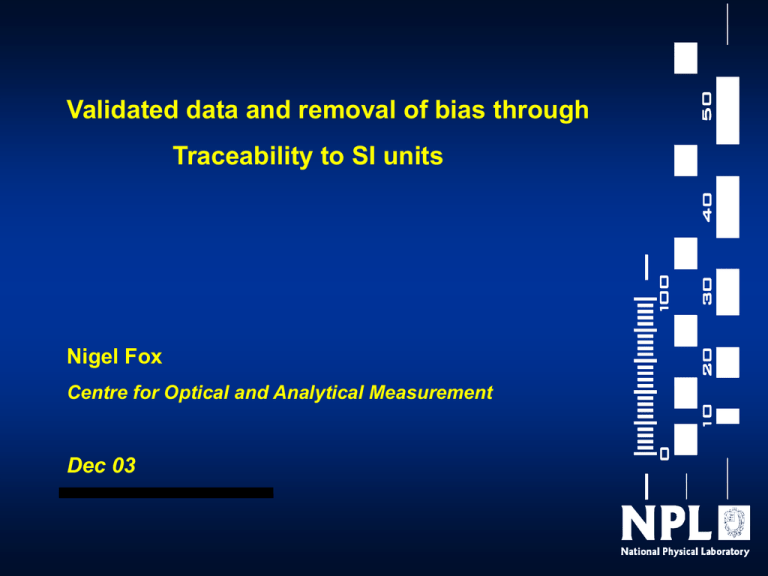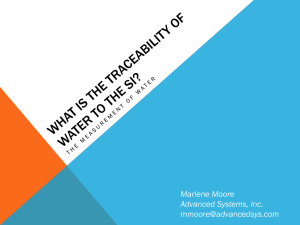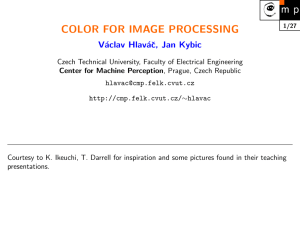Validated data and removal of bias through Traceability to SI units
advertisement

Validated data and removal of bias through Traceability to SI units Nigel Fox Centre for Optical and Analytical Measurement Dec 03 Resolution adopted by CEOS Plenary 14 (Nov 2000) 1/ All EO measurement systems should be verified traceable to SI units for all appropriate measurands. 2/ Pre-launch calibration should be performed using equipment and techniques that can be demonstrably traceable to and consistent with the SI system of units, and traceability should be maintained throughout the lifetime of the mission. Traceability – Property of the result of a measurement or the value of a standard whereby it can be related to stated references, usually through an unbroken chain of comparisons all having stated uncertainties Vocabulary for International Metrology (VIM) SI units – The coherent system of units adopted and recommended by the General Conference of Weights and Measures (CGPM). Accuracy of measurement – Closeness ofParameter, associated with the the agreement between the result of a result Uncertainty of measurement – of a measurement, that measurement and a true value of the Parameter, associated with the result of characterises the dispersion of the a measurement, that characterises the measurand. values that could be dispersion of thereasonably values that could reasonably be attributed to the attributed to the measurand. Precision – No –metrological Error of measurement Result of a measurand. measurement minus a to truestate value that of theit definition except measurand Stability – Ability of a measuring should never be used in the context instrument to maintain constant its Precision – No metrological definition of “accuracy” and, because of metrological characteristics with time. except to state that it should never be possible confusion its use, should Reproducibility of results of measurements – Closeness of the agreement between the results of measurements of the same measurand carried out under changed Uncertainty of measurement – conditions of measurement. used in the context of “accuracy” and, Traceability – Property of the result of a normally be avoided in metrological because of possible confusion its use, measurement or the value of a standard applications. should normally be avoided in whereby it can be related to stated metrological applications. references, usually through an unbroken chain of comparisons all Repeatability of results of measurements – having stated uncertainties. closeness of the agreement between the results of successive measurements of the same measurand carried out under the same conditions of measurement. Convention of the Meter – established 1875 CPGM Conference Generale des Poids et Mesures 66 member & associate states CIPM Comite International des Poids et Measures BIPM Bureau de International des Poids et Mesures CCPR Consultative Committee for Photometry and Radiometry CCT Consultative Committee for Thermometry RMO Regional Metrology Organisation CCM Consultative Committee for Mass and Related Quantities CC... SI Traceability: The Mututal Recognition Arrangement (MRA) CCPR SIM CCPR Key comparisons • Spectral Irradiance • Spectral Responsivity • Luminous intensity • Luminous Flux • Spectral transmittance • Spectral diffuse reflectance (total hemispherical) Monitoring and interpreting the Earth’ systems Incoming Solar Radiation Drives all the processes of the Earth System and potentially damaging (UV) to Biosphere (Human health) Solar Reflected Radiation Atmosphere - Aerosol (size & distribn) - Clouds - Pollution (impact on health) Water - Pollution (originator) - Algae plumes Land - Useage / condition - Type/quantity of vegetation - Minerals - Carbon & hydrological cycles Governments – Treaties, Tax, Planning Spatial variability requires good stability and SNR (signal to noise ratio) from a single sensor - but long term studies “climate change” need accuracy and consistency Engineering specification of SNR should equate to accuracy Thermal Emitted Radiation Atmosphere – Atmospheric chemistry Water – Temperature Land – Fires, Volcanoes, Pollution, Need Need for for improved improved Quality Quality Assurance Assurance Anomalies in NOAA/AVHRR data N-6 N-7 N-9 N-11 N-14 Requirement - baseline for climate studies - improve models - prediction of weather systems - identify crops from weeds Total solar Irradiance (Solar Difficulties constant) – only normalisation - bias between allows asensors long term record to be established (Biases are 10 X - instruments change on launchtoand larger than necessary detect impact on climate degrade in-orbit (gain andchange) spectral) - application of correction for atmosphere loss - global warming - Man or Nature? - lack of cohesion between networks and - detection of change Normalised Difference Vegetation “ground truth” validation data (atmosphere Index (NDVI) over “stable” desert asan exception) - monitoring the treaties measured AVHRR - auditing by carbon sinks - models inadequate efficiency of carbon –- Demonstrates bothsinks in-flight “ageing” and initial calibration biases - QA of operational services (GMES) - no consistent statements of uncertainty or LOS 1998 IEEE Trans G & RS - instrument synergychange difficult to identify confidence. Temporal even using “identical” instrumentation without normalisation To strengthen the evidence Traceability chain for optical radiation measurement Electrical Substitution Radiometry a 100 yr old technology When thermometer temperature T=To=TE then Po=PE Optical power =Po Absorbing black coating Electrical Heater Power = PE Copper disk Thermal shroud Optical power =Po When T =To=TE then Po=PE Mechanical cryogenic cooler “Fridge” (T = 20 K) Shutter Cooling improves sensitivity by 1000 X Absorbing cavity (~ 0.99999) Electrical Heater Power = PE Principle of Cryogenic radiometry 25 yrs of cryogenic radiometry at NPL Fundamental constants (SI) Primary standard lamp Satellite Pre-flight Lamp performance: FELs (approx 1 in 3 show a deviation) Calibration Primary standard cryogenic radiometer Spectroradiometer Traceability ?? Laser Cal interval ~100nm 4.00% 4.5% 2.00% Cal interval ~0.1 nm -4.00% -6.00% Filter Radiometer-8.00% -10.00% Radiance Temperature -12.00% -14.00% Ultra High Temperature Black Body (3500 K) Radiance continuum (Planck) Primary Scale 4.0% 3.5% Cal Lab Primary lamp 3.0% Spectroradiometer BB radiance Solar Lamp SRIPS Repeatability illuminated UVFW modelling Diffuser 2.5% 2.0% Vicarious Cal Lab working std Lamp 1.5% Spectroradiometer 1.0% 250 0.5% 500 0.0% 250 750 500 1000 1250 1500 User Cal Lamp Wavelength 750 1000 1750 1250 1500 1750 Wavelength (nm) User Instrument LAND OCEAN Atmosphere/ Model 2000 2250 2000 2250 Data products Spectroradiometer (multi-band filter radiometer Spectral Radiance/Irradiance calibrations Satellite In-flight Calibration Spectroradiometer Radiance uncertainty (%) Difference Photodiode (spectral responsivity0.00% -2.00% Laser SRIPS primary scale uncertainty: Working lamp Overall at standard 95% confidence level ATMOSPHERE 2500 2500 Traceability for in-flight / in-situ / vicarious calibration Diffuse reflectance (BRDF) Spectral Radiance The NPL diffuse reflectance scale is derived goniometrically for the spectral region 300 to 2500 nm - lamp illuminated spheres - Filter radiometers (spectroradiometers) - Irradiance source + diffuser Via models / atmosphere correction Lamp + spectralon or …. Uncertainty of <0.2 % in to visible satellite for cal/val the and shown equivalence with NIST Sun + spectralon or …. (radiances) Sun + Moon Spectralon 400 nm Detector To bio/geophysical quantities Sample (refelectances) 1.05 radiance factor Spectral Reflectance -0.95in-situ absolute ratio (using radiometers) -0.85Ratio to “standard” reflector/diffuser Beta-NPL (400 nm), Tile 1 Beta-PTB (400 nm), Tile 1 0.75 Beta-NPL (400 nm), Tile 2 Beta-NIST (400 nm), Tile 2 0.65 -90 -60 -30 0 30 60 90 Validated data products require all processing steps and data to be QA – Accredited? Pre-flight User specification - Instrument build compliance - Calibration? Post-launch - In-flight checks - Ground “Truth” comparison - Inter-sensor cross calibration Processed data released - “validated” - Uncertainty statement? - Rare for all these activities to have been independently reviewed and/or audited Global Monitoring Environment and Security (GMES) Joint initiative of ESA and EU Aim: to establish “operational services” for Earth Observation data to meet needs of key stakeholders , public services, private industry, academia and the citizen with a view to financial self-sufficiency. Success requires: - Combination of data from many sources, (satellites, in-situ, aircraft) - Efficient production of cost effective, reliable, data products / maps - Data must provide the evidence to allow decisions to be taken with confidence. - Innovation in measurement and analysis Reliability: Implies Quality assurance and statements of confidence associated with data (not only for end users but also “operational service” providers Users generally assume QA Robust evidence requires robust QA Infrastructure for innovation in measurement, validation and QA of EO data • Transfer standards • Comparisons Post-launch airborne • Measurement & test protocols • International link NPL ++ Modelling & Data processing • Innovation on techniques • Independence NIST ++ Calibration QA Traceability Pre-flight In-situ Advice Public sector Audit Validation Private Industry Academia Summary Primary scales, transfer standards and techniques now allow high accuracy to be achieved for both pre-flight and vicarious calibration (particularly for radiance) All aspects/steps of producing EO data products needs validation and traceability (instrument calibration and algorithms/models) Consistent presentation and breakdown of uncertainty budgets Flexibility to allow innovation Regular comparisons to evaluate biases Establish well characterised ground targets as “reference standards” Develop improved “in-flight” calibration methods e.g TRUTHS (Fox et al Proc. SPIE 4881, p395 2003) For Earth Observation to provide the evidence to support policy requires the industry and its data to be as robust as traditional industries



